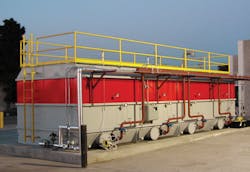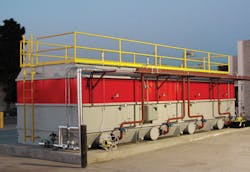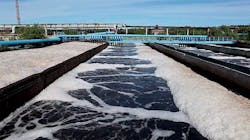By Steve Lupton and Bill Sheridan
Specialty chemical wastewater streams are plagued with residual organics, including aromatics, amines and various derivatives. Honeywell UOP’s XCeed bioreactor technology is an enabling process for bulk treatment of contaminants in a variety of applications and diverse waste streams. It can also be used in polishing and reuse applications.
The system’s compartmentalized plug-flow design and sophisticated biological population lead to highly efficient treatment with low sludge generation, low operational and maintenance costs, and low component replacement costs. The technology has been incorporated in several specialty chemical applications to meet regulatory discharge requirements.
Customer Challenge
A specialty chemicals plant in Castanea, Pa., manufactures a wide-range of chemicals, including: dye intermediates, phenol derivatives, aniline, chlorobenzene, nitrobenzene, nitriles, and aromatic amines.
Due to the batch nature of the production of these chemicals, the wastewater generated by the plant varies considerably, not only in the biological oxygen demand (BOD) strength of the wastewater but also in the organic composition that contributes to the BOD. The local sewer authority implemented a surcharge requiring the facility to pay a fee when BOD levels in the discharged wastewater were greater than 300 mg/L. Due to the variability of the plant’s specialty chemicals production, the facility’s wastewater BOD concentration could measure upwards of 10,000 mg/L. Given these conditions, the plant faced prohibitively high surcharges for disposing its wastewater to the local sewer and needed to find a more economical solution.
Solution
The customer conducted an extensive onsite pilot of UOP’s XCeed bioreactor technology, treating actual wastewater generated from the site over a period of months. During this pilot study, the bioreactor system was able to tolerate the wide variability of organics composition and concentration in the plant’s wastewater while maintaining a final BOD measurement of <300 mg/L.
The XCeed bioreactor system has several key technology features, including low energy demand, which results in lower operating and maintenance costs than alternative systems. It also generates 70-80 percent less waste solids relative to membrane bioreactors (MBRs), and up to 60-70 percent less waste solids than moving bed bioreactors (MBBRs). Other features include high effluent quality with low sludge generation; sophisticated lab and analytical capabilities to ensure efficient and effective process design for customer solutions; and a modular system design that offers mechanical simplicity, compact size and flexible configuration.
Results
As a result of the successful pilot study, the customer implemented a full-scale XCeed bioreactor treatment system at this site, including up-front equalization tanks and two bioreactor modules, which operated in parallel to treat the plant’s wastewater. The combination of equalization tanks and the unique plug-flow characteristics of the bioreactor system resulted in consistently meeting the BOD surcharge limit and lowering specific toxic organic constituents such as chlorobenzene, toluene, phenol and acrylonitrile below the level of detection.
About the Authors:
Dr. Steve Lupton is a senior research associate in UOP’s Development group, which supports Honeywell UOP’s Industrial Water Technologies business. Dr. Lupton specializes in the application of bioprocessing for renewable energy and industrial wastewater treatment applications. He has a BS and PhD in environmental microbiology from the University of New South Wales, Australia.
Bill Sheridan is the operations manager for Honeywell UOP’s Industrial Water Technologies business. As an applied scientist, he has developed and applied fixed-film biological technologies to the treatment of complex wastewater and gas-phase streams for decades. In his current role, he oversees the use and development of engineering tools to design custom solutions for difficult to treat industrial wastewater problems. Sheridan has a BS and MS in environmental microbiology from the University of Illinois.




